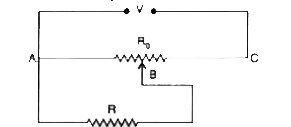Write any three experimental observations of photoelectric effect Solution in Kannada
(i) The photoelectric emission is an instantaneous process without any apparent time lag (~10−9 s or less), even when the incident radiation is made exceeding by dim.
(ii) For every photo emissive surface there is a certain minimum frequency of the incident radiation below which there is no photoelectric effect, called threshold frequency and the corresponding wavelength is called threshold wavelength no matter how intense the incident light is. Threshold frequency is different for different materials.
(iii) For a frequency greater than the threshold frequency, the strength of the photoelectric current is directly proportional to the intensity of the incident radiation.
Topper's Solved these Questions
- DUAL NATURE OF RADIATION AND MATTERBOOK - OSWAAL PUBLICATIONCHAPTER - DUAL NATURE OF RADIATION AND MATTEREXERCISE - TOPIC-1 PHOTOELECTRIC EFFECT (LONG ANSWER TYPE QUESTIONS)
4 Videos
- DUAL NATURE OF RADIATION AND MATTERBOOK - OSWAAL PUBLICATIONCHAPTER - DUAL NATURE OF RADIATION AND MATTEREXERCISE - TOPIC-1 PHOTOELECTRIC EFFECT (NUMERICAL PROBLEMS)
15 Videos
- DUAL NATURE OF RADIATION AND MATTERBOOK - OSWAAL PUBLICATIONCHAPTER - DUAL NATURE OF RADIATION AND MATTEREXERCISE - TOPIC-1 PHOTOELECTRIC EFFECT (SHORT ANSWER TYPE QUESTIONS-I)
6 Videos
- CURRENT ELECTRICITY BOOK - OSWAAL PUBLICATIONCHAPTER - CURRENT ELECTRICITY EXERCISE - TOPIC-3 (POTENTIOMETER & APPLICATIONS) (NUMERICAL PROBLEMS)
2 Videos
- ELECTRIC CHARGES & FIELDSBOOK - OSWAAL PUBLICATIONCHAPTER - ELECTRIC CHARGES & FIELDSEXERCISE - (TOPIC -2)Numerical Problems
5 Videos
Similar Questions
Write any three experimental observations of photoelectric effect
View SolutionThe threshold wavelength of a photosensitive metal is 662.5 nm. If this metal is irradiated with a radiation of wavelength 331.3 nm, find the maximum kinetic energy of the photoelectrons. If the wavelength of radiation is increased to 496.5 nm, calculate the change in maximum kinetic energy of the photoelectrons. (Planck's constant h=6.625×10−34 Js and speed of light in vacuum=3×108ms−1)
View SolutionWhat is a photo diode? In which mode of biasing does it work?
View SolutionA resistance of RΩ draws current from a potentiometer. The potentiometer has a total resistance R0Ω.A voltage V is supplied to the potentiometer. Derive an expression for the voltage across R when the sliding contact is in the middle of the potentiometer.

View SolutionAn atom was earlier assumed to be sphere of radius a having a positively charged point nucleus of charge +Ze at its centre . This nucleus was believed to be surrounded by a uniform desity of negative charge that made the atom neutral as a whole.
Use this theorem to find the electric field of this atom at a distance r(r>a) from the centre of the atom.
View SolutionExplain experimentally observed facts of photoelectric effect with the help of Einstein's explanation.
View SolutionWrite any three experimental observations of photoelectric effect
View SolutionWrite any three experimental observations of photoelectric effect
View SolutionWrite the five experimental observations of photoelectric effect.
View SolutionWrite any three experimental observations of photoelectric effect
View SolutionWrite any three experimental observations of photoelectric effect
View SolutionExplain experimentally observed facts of photoelectric effect with the help of Einstein's explanation.
View SolutionDescribe briefly three experimentally observed features in the phenomenon of photoelectric effect.
View SolutionWrite any three experimental observations of photoelectric effect
View SolutionWrite any three experimental observations of photoelectric effect
View SolutionWrite three experimental observation of photoelectric effect.
View Solution
